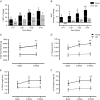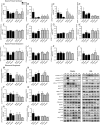Synchronous deficits in cumulative muscle protein synthesis and ribosomal biogenesis underlie age-related anabolic resistance to exercise in humans
- PMID: 27654940
- PMCID: PMC5157077
- DOI: 10.1113/JP272857
Synchronous deficits in cumulative muscle protein synthesis and ribosomal biogenesis underlie age-related anabolic resistance to exercise in humans
Abstract
Key points: Resistance exercise training (RET) is one of the most effective strategies for preventing declines in skeletal muscle mass and strength with age. Hypertrophic responses to RET with age are diminished compared to younger individuals. In response to 6 weeks RET, we found blunted hypertrophic responses with age are underpinned by chronic deficits in long-term muscle protein synthesis. We show this is likely to be the result of multifactorial deficits in anabolic hormones and blunted translational efficiency and capacity. These results provide great insight into age-related exercise adaptations and provide a platform on which to devise appropriate nutritional and exercise interventions on a longer term basis.
Abstract: Ageing is associated with impaired hypertrophic responses to resistance exercise training (RET). Here we investigated the aetiology of 'anabolic resistance' in older humans. Twenty healthy male individuals, 10 younger (Y; 23 ± 1 years) and 10 older (O; 69 ± 3 years), performed 6 weeks unilateral RET (6 × 8 repetitions, 75% of one repetition maximum (1-RM), 3 times per week). After baseline bilateral vastus lateralis (VL) muscle biopsies, subjects consumed 150 ml D2 O (70 atom%; thereafter 50 ml week-1 ), further bilateral VL muscle biopsies were taken at 3 and 6 weeks to quantify muscle protein synthesis (MPS) via gas chromatography-pyrolysis-isotope ratio mass spectrometry. After RET, 1-RM increased in Y (+35 ± 4%) and O (+25 ± 3%; P < 0.01), while MVC increased in Y (+21 ± 5%; P < 0.01) but not O (+6 ± 3%; not significant (NS)). In comparison to Y, O displayed blunted RET-induced increases in muscle thickness (at 3 and 6 weeks, respectively, Y: +8 ± 1% and +11 ± 2%, P < 0.01; O: +2.6 ± 1% and +3.5 ± 2%, NS). While 'basal' longer term MPS was identical between Y and O (∼1.35 ± 0.1% day-1 ), MPS increased in response to RET only in Y (3 weeks, Y: 1.61 ± 0.1% day-1 ; O: 1.49 ± 0.1% day-1 ). Consistent with this, O exhibited inferior ribosomal biogenesis (RNA:DNA ratio and c-MYC induction: Y: +4 ± 2 fold change; O: +1.9 ± 1 fold change), translational efficiency (S6K1 phosphorylation, Y: +10 ± 4 fold change; O: +4 ± 2 fold change) and anabolic hormone milieu (testosterone, Y: 367 ± 19; O: 274 ± 19 ng dl-1 (all P < 0.05). Anabolic resistance is thus multifactorial.
Keywords: ageing; exercise; hypertrophy; muscle; protein synthesis; ribosomal biogenesis; signalling; stable isotope.
© 2016 The Authors. The Journal of Physiology published by John Wiley & Sons Ltd on behalf of The Physiological Society.
Figures






Comment in
-
Impaired ribosome biogenesis could contribute to anabolic resistance to strength exercise in the elderly.J Physiol. 2017 Mar 1;595(5):1447-1448. doi: 10.1113/JP273773. Epub 2017 Jan 19. J Physiol. 2017. PMID: 28105708 Free PMC article. No abstract available.
-
Less is more: the role of mTORC1 activation in the progression of ageing-mediated anabolic resistance.J Physiol. 2017 May 1;595(9):2781-2782. doi: 10.1113/JP274154. J Physiol. 2017. PMID: 28233314 Free PMC article. No abstract available.
Similar articles
-
Testosterone therapy induces molecular programming augmenting physiological adaptations to resistance exercise in older men.J Cachexia Sarcopenia Muscle. 2019 Dec;10(6):1276-1294. doi: 10.1002/jcsm.12472. Epub 2019 Sep 30. J Cachexia Sarcopenia Muscle. 2019. PMID: 31568675 Free PMC article. Clinical Trial.
-
Skeletal muscle hypertrophy adaptations predominate in the early stages of resistance exercise training, matching deuterium oxide-derived measures of muscle protein synthesis and mechanistic target of rapamycin complex 1 signaling.FASEB J. 2015 Nov;29(11):4485-96. doi: 10.1096/fj.15-273755. Epub 2015 Jul 13. FASEB J. 2015. PMID: 26169934 Clinical Trial.
-
A double-blind placebo controlled trial into the impacts of HMB supplementation and exercise on free-living muscle protein synthesis, muscle mass and function, in older adults.Clin Nutr. 2019 Oct;38(5):2071-2078. doi: 10.1016/j.clnu.2018.09.025. Epub 2018 Sep 27. Clin Nutr. 2019. PMID: 30360984 Free PMC article. Clinical Trial.
-
Role of Ingested Amino Acids and Protein in the Promotion of Resistance Exercise-Induced Muscle Protein Anabolism.J Nutr. 2016 Feb;146(2):155-83. doi: 10.3945/jn.114.203208. Epub 2016 Jan 13. J Nutr. 2016. PMID: 26764320 Free PMC article. Review.
-
Anabolic processes in human skeletal muscle: restoring the identities of growth hormone and testosterone.Phys Sportsmed. 2010 Oct;38(3):97-104. doi: 10.3810/psm.2010.10.1814. Phys Sportsmed. 2010. PMID: 20959702 Review.
Cited by
-
Regulation of Ribosome Biogenesis in Skeletal Muscle Hypertrophy.Physiology (Bethesda). 2019 Jan 1;34(1):30-42. doi: 10.1152/physiol.00034.2018. Physiology (Bethesda). 2019. PMID: 30540235 Free PMC article. Review.
-
Phytochemical compound PB125 attenuates skeletal muscle mitochondrial dysfunction and impaired proteostasis in a model of musculoskeletal decline.J Physiol. 2023 Jun;601(11):2189-2216. doi: 10.1113/JP282273. Epub 2022 Aug 26. J Physiol. 2023. PMID: 35924591 Free PMC article.
-
Physical activity and exercise: Strategies to manage frailty.Redox Biol. 2020 Aug;35:101513. doi: 10.1016/j.redox.2020.101513. Epub 2020 Mar 20. Redox Biol. 2020. PMID: 32234291 Free PMC article. Review.
-
Greater myofibrillar protein synthesis following weight-bearing activity in obese old compared with non-obese old and young individuals.Geroscience. 2024 Aug;46(4):3759-3778. doi: 10.1007/s11357-023-00833-2. Epub 2023 Jun 17. Geroscience. 2024. PMID: 37328646 Free PMC article.
-
Geroprotector drugs and exercise: friends or foes on healthy longevity?BMC Biol. 2023 Dec 8;21(1):287. doi: 10.1186/s12915-023-01779-9. BMC Biol. 2023. PMID: 38066609 Free PMC article. Review.
References
-
- Atherton PJ, Etheridge T, Watt PW, Wilkinson D, Selby A, Rankin D, Smith K & Rennie MJ (2010). Muscle full effect after oral protein: Time‐dependent concordance and discordance between human muscle protein synthesis and mTORC1 signaling. Am J Clin Nutr 92, 1080–1088. - PubMed
-
- Atherton PJ, Miller BF, Burd NA, et al (2015). Commentaries on Viewpoint: What is the relationship between acute measure of muscle protein synthesis and changes in muscle mass? J Appl Physiol 118, 498–503.
-
- Baar K & Esser K (1999). Phosphorylation of p70(S6k) correlates with increased skeletal muscle mass following resistance exercise.Am J Physiol Cell Physiol 276, C120–C127. - PubMed
Publication types
MeSH terms
Substances
Grants and funding
LinkOut - more resources
Full Text Sources
Other Literature Sources
Medical
Miscellaneous

